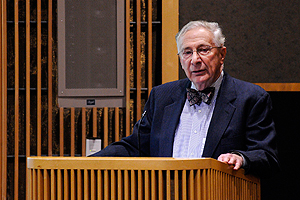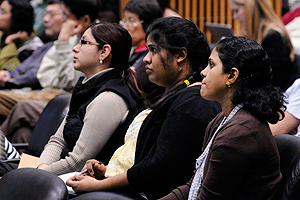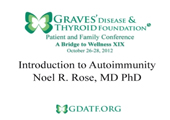Autoimmunity expert delivers distinguished lecture
By Sheetal Thakur

“The most disturbing aspect is that the incidences of autoimmune disorders are going up,” Rose said. “It is really an environmental problem, and it’s going to get worse unless we pay attention to it.” (Photo courtesy of Steve McCaw)

Fred Miller, M.D., Ph.D. , left, acting director of the NIEHS Clinical Research Program and head of the Environmental Autoimmunity Group, shared Germolec’s enthusiasm about the lecture. (Photo courtesy of Steve McCaw)

Postdoctoral fellows from the Laboratory of Signal Transduction, left to right, Diana Cruz, Ph.D., Mahita Kadmiel, Ph.D. and Sivapriya Ramamoorthy, Ph.D., also said they enjoyed the seminar. (Photo courtesy of Steve McCaw)
NIEHS opened its 2012-2013 Distinguished Lecture series with a seminar on autoimmune diseases, disorders caused by a person’s immune system erroneously attacking its own healthy tissues. Noel Rose, M.D., Ph.D., a leading autoimmunity expert, came to NIEHS Jan. 8 and presented “Myocarditis: an environmentally induced autoimmune disease.” Dori Germolec, Ph.D., head of the Systems Toxicology Group in the NTP Toxicology Branch , hosted the event.
Linked Video
Introduction to Autoimmunity at an October 2012 conference (50:52)
(Launches in new window)
Download Media Player: Flashhttp://get.adobe.com/flashplayer/
Rose (http://www.jhsph.edu/faculty/directory/profile/3787/Rose/Noel) is a professor of molecular microbiology and immunology and director of the Center for Autoimmune Disease Research at Johns Hopkins Bloomberg School of Public Health. During Germolec’s introduction, she described Rose as one of the founding fathers of immunology and autoimmunity research. She particularly emphasized his early pioneering discoveries in which he and his colleagues were the first to model Hashimoto’s thyroiditis, an autoimmune disease that causes chronic inflammation of the thyroid gland, in a number of species ranging from chickens to primates. She listed awards from his impressive list of accomplishments, and praised his outstanding mentorship record of guiding approximately 120 students and postdoctoral fellows during his career.
Rose’s laboratory focuses on elucidating the commonalities that underlie various autoimmune diseases. Early in his talk, he emphasized that seemingly diverse autoimmune diseases belong to the same family and have many common genetic traits and environmental triggers. He explained that these common traits determine whether an organism will be susceptible or resistant to developing autoimmune disorders.
“If we are ever going to find a way of actually curing an autoimmune disease,” Rose remarked, “I believe it is going to come from our understanding of what those common traits are.”
Environmental triggers to autoimmune myocarditis
According to Rose, viral myocarditis is usually a self-limiting disease, with most of the affected people completely recovering without showing any outward appearance of the disease. The condition may develop into an autoimmune disorder in a few individuals. Autoimmune myocarditis is usually manageable with medication, unless it progresses to a fibrotic state in the heart known as dilated cardiac myocarditis (DCM). The only cure for DCM is heart replacement. Rose and his group have previously demonstrated that environmental chemicals and agents, such as inorganic mercury and bacterial lipopolysaccharide, intensify the virally induced autoimmune myocarditis and DCM.
Cytokines and autoimmune myocarditis
Rose uses different strains of mice, with varying susceptibility, to investigate the role of inflammatory cells and cytokines in progression from initial virus infection to a heart-specific autoimmune disease. In murine models, autoimmune myocarditis can be initiated by infection with coxsackievirus B3 or by immunizing with cardiac myosin.
Rose discussed the influence of effector T-cell subpopulations and different cytokines in autoimmune cardiac inflammation and progression to DCM. He mentioned that all three effector T-cell pathways Th1, Th2, and Th17 are important, and their relative involvement determines disease outcome. He discussed findings from his laboratory, which demonstrated the crucial roles that two cytokines with different mechanisms — interferon-gamma (IFN-gamma) and interleukin 17 (IL-17) — play in the progression from initial viral infection to DCM and death. IFN-gamma is involved in reducing the severity of the inflammatory response, while IL-17 is essential for progression to the fatal fibrotic DCM.
Rose concluded his talk by saying that, at present, autoimmune diseases cannot be cured, but they can potentially be prevented.
“The most efficient way of preventing autoimmune diseases would be by identifying and separating the susceptible human from the responsible environmental factor,” he said.
(Sheetal Thakur, Ph.D., is an Intramural Research Training Award fellow in the NTP Toxicology Branch.)
"New logo emphasizes NIH ..." - previous story ![]()
![]() next story - "Nano meeting tackles consumer ..."
next story - "Nano meeting tackles consumer ..."
February 2013 Cover Page



